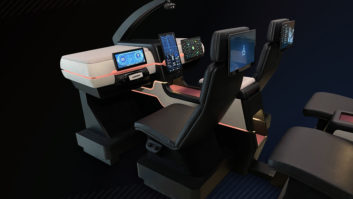The recent introduction of DTS AutoStage listener heat maps by Xperi made an impression on me. It got me wondering what other tools are available to today’s radio managers to provide insight into listener behavior, sales opportunities in local markets and radio’s own internal business processes.
For this article, which originally appeared in a Radio World ebook, I asked several experts about tools that provide what I call actionable business intelligence. It’s an area rich with options to help programmers and salespeople.
“There are a million numbers out there, though revenue is still the most important one in commercial radio,” said digital strategist Seth Resler.
But when it comes to analytics, Resler encourages broadcasters to gather data themselves as much as possible — a person’s name, email address and Zip code are valuable pieces of information. “Ideally, it also includes behavioral data — for example, did they click on a link to an article about the Foo Fighters? Do they open emails about concert announcements?”
Resler has blogged on the value of first-party data; access that here.
Broad market understanding
Pierre Bouvard, chief insights officer for Cumulus Media and Westwood One, says any manager will of course start with the Nielsen Audio ratings to understand the audience for terrestrial, streaming and podcasting.
“But if you want to know how America is consuming audio more broadly, there is a syndicated measurement service that comes out quarterly called ‘Share of Ear.’”
Published by Edison Research, Share of Ear is an audio listening diary survey that measures all audio that the respondents listen to during a 24-hour period and reports on what they’re listening to, how much they listen and when, where they listen and what devices they use.
“I don’t think there’s a database out there that can do more to tell you about the state of audio, especially on the ad-supported platforms,” Bouvard said.
“For many years, our industry thought that our biggest competitors were Pandora and Spotify; but what you realize when you look at Share of Ear is that they’re not,” he continued.
“Pandora’s audience is collapsing; it used to be a 12 share but now it’s a 6 share. And you realize that Spotify is not a competitor to radio. Their ad-supported service has about a 4 share while radio’s ad-supported share is a 69 share. We dwarf them.”
What Spotify excels at, he said, is building a subscription ad-free service, and that audience has exploded. But it’s not an advertising competitor to commercial radio.
“What Share of Ear has done is slay mythological dragons about where the audience is really going. It’s not to Spotify. It’s not to Pandora. It’s to podcasting — and that’s exciting because we in radio know how to do it. It’s personalities. It’s spoken word, it’s entertaining conversations. It’s interviews,” Bouvard said.
But this does mean radio stations need a podcasting strategy. “When you see that the 25–54 share for podcasting has gone from a 5 to a 25? Whoa, then you know.”
For learning about the behavior of listeners to your own station, Bouvard has evangelized about the data provided by Xperi’s new DTS AutoStage hybrid radio platform.
“For many years programmers and sales managers have been able to do Zip code runs with Nielsen data to learn where the audience is. That approach uses home Zip codes, which is useful,” he said.
“But what makes the DTS tool unique is that two-thirds of American radio listening occurs out of the home — roaming around town, going to work, doing errands. With the DTS data, you know where the car is and you know what people have been listening to. Well, if I’m a retailer north of town and your station’s audience tends to hang out on the north side of town, that’s really helpful to know.”
The DTS tool can also help overcome a client’s misperceptions about your station’s lack of reach into communities other than your city of license. “In more rural or local markets, many people buy on perception.”
What about figuring our who’s listening online?
“For the vast majority of the industry, Triton Digital is the ad tech company of record for streaming,” Bouvard said. The company offers a range of services related to digital and online content, including ad insertion, sales of ads to national advertisers and audience measurement.
‘They can monitor the streams and look at the hour-by-hour pattern. One of the things you learn through Triton is that streaming listenership is 9 to 5, tracking the workday. People use the stream while they work, a different pattern than in the car, where we see surges in the morning when people are driving,” he said.
“The beauty of this tool is that it’s not based on a sample but on all of the internet connections that were streaming your station.” Even if you’re in a very small market, you can still get data about your station, about who your listeners are and whether you are attracting some of them from outside your market.
“Triton will tell you that a lot of sports stations attract people who used to live in a market and now are somewhere else but still have an affinity for the local teams and like to listen to the sports talk about their favorite team.” A streaming services provider like Triton can also tell you what percentage of your station audience is listening on smart speakers or on your app.
Boosting sales
Many of the analytics tools available in radio focus on the needs of its salespeople.
One that Bouvard recommends is Scarborough from Nielsen, which captures national and local consumer insights across various leisure activities, shopping behaviors, purchasing patterns and media consumption.
“It can show you in a local market what people buy and where they shop in that town — for instance, car dealers or furniture dealers in Cincinnati. Most people in radio view it as a sales tool, but Scarborough also does multimedia measurement. It measures tuning to cable channels in your market, local TV station viewership and the use of digital platforms.”
Hubbard Broadcasting researcher Mike Bustell recently pointed out that Scarborough data often shows radio stations beating OTA television in audience, contrary to longstanding conventional thinking about the power of TV.
Bouvard said, “So you can go into Scarborough and ask, ‘Okay, what’s the reach of TV versus radio? Oh my gosh, radio beats TV? What about radio versus cable?’ There’s a lot of insight there.”
He says stations might also consider using “top of mind” awareness studies that ask consumers in a market to name the local car dealerships or roofing companies that come to their mind.
“The most important answer is ‘I don’t know.’ If 50% of people don’t know, your salesperson can show that to a client and point out an opportunity,” he said.
“Local retailers often think ‘My competitor is Steve’s Pest Control,’ not realizing that when half of the people in their town can’t name a pest control company at all. That’s a client’s opportunity to get famous. You can do a TOMA study easily yourself or hire a local community college or statistics group.”
Or for a sense of how your organization’s revenue is pacing or whether your sales team is pricing ads efficiently, you might turn to a company like Revenue Analytics that specializes in pricing software and streamlining a station’s sales workflow. Or to understand the state of advertising in a local market, you might look at Miller Kaplan’s revenue reports, which look at top-line market share and revenue growth.
“Miller Kaplan can tell you the state of advertising in your local market, based on data coming from you and all of your competitors,” Bouvard said. “It’ll also tell you your share of the market. It won’t tell you what your competitors’ shares are; but if your revenue is up 5% while the market was up 15%, you know someone else is getting that growth.” Miller Kaplan also offers X-Ray reports that give insights about individual advertisers or ad categories.
If you want even broader information about your local market, Bouvard said, the firm Borrell offers data and insights on how local businesses spend their marketing budgets.
“It can tell you what businesses are spending on all forms of media advertising as well as other marketing, and configure it for any geography down to the county level. They can tell you how much total advertising is being spent in your local market, including on Google and Facebook and online video; and they do this for even the smallest markets in America.”
Such a tool can be very useful when radio companies find themselves behaving more and more like mini advertising agencies.
“A salesperson will come to a retailer and say, ‘I’m not just here selling radio. Tell me your marketing challenge. I’ll put together a campaign that might have online video, it might have connected TV or radio or email.’”
Borrell also conducts advertiser agency surveys, asking advertisers which media do the best job of needs analysis or of integrated marketing. “They can give radio a report card of how our salespeople collectively are doing versus cable or newspaper sellers, for instance,” Bouvard said.
Competitive insights
Mike McVay, president of consulting firm McVay Media, notes the dominance of Mediabase, a reporting service that provides airplay information and insights about consumer listening trends. It monitors music airplay of approximately 1,800 media outlets in 160 markets.
“It does more than only tracking music. It will show you where stations are breaking, which gives insight into what
the competition is doing,” he said.
Meanwhile Media Monitors, using broadcast monitoring technology, lets a user see which commercials are running and where.
“Click the market, specify a date range, and generate a list of accounts that ran on the respective stations,” the Media Monitors website explains. “Generate reports that show occurrences and expenditure data for each account in near real-time. … See exact dates and air time, parent company, category affiliation, pod position and spot duration. Clicking on the speaker icon will allow you to listen to the spot, and download it.”
McVay also likes a tool called SpotGPS, developed by Ralph Cipolla and distributed by Benztown. It uses airplay data to produce station spot analyses, letting the user assess and compare any hour, quarter-hour, daypart, day or multi-day totals and averages, as well as spots, songs or other on-air events. By confirming placement and quantity of breaks and sweeps, the company says, the tool helps a manager adjust and counter-program.
McVay used it in the past while working for Cumulus. “You could look at an hour and see if your competitor was playing a better song than you, or if they were in commercials, or if you were playing a better song than them. I always felt that was one of our secret weapons.”
New on McVay’s radar is Barometer, a tool that supports “brand safety and suitability.” The company promises AI-powered insights to optimize digital audio advertising.
“Right now they’re just using it for podcasting,” McVay said. “But their approach is to go to advertisers and say, ‘Okay, you’re buying bulk, but you may be political-averse or controversy-averse. This tool looks at a wide field of podcasts and analyzes if the content of the podcast is a fit for the advertiser.
“They showed me an example of a podcast that had the ‘F word’ mentioned 17 times. With this tool, someone buying through a digital company like Townsquare’s Ignite would be able to say ‘Don’t buy these specific podcasts.’”
And McVay is impressed by a platform called Spintel that caters to the music industry. It’s a suite of analytical and management tools that help users “visualize and decipher terrestrial radio airplay data” to help find growth opportunities for records.
“I see applications for it to radio,” McVay said, “because it aggregates information about songs that are played … not just on reporting radio stations, but on streaming channels, satellite syndication and other platforms.”
Focus on first-party
A related topic of note in this discussion is the move away from third-party cookies that track a user’s browsing history and activities.
“The digital advertising industry is moving away from third-party cookies based on changing user expectations and global regulations,” wrote NAB PILOT in a report earlier this year.
“This could create a $2.1 billion loss in annual digital revenue for the broadcast industry. Without question, this is the highest priority for digital leaders at broadcast companies.”
PILOT, with support from the Google News Initiative, created an accelerator program focused on direct-to-consumer strategies to “help broadcasters leverage audiences that have largely remained anonymous, while also ensuring privacy protections.” Media companies like Beasley Media Group, Hubbard Radio, Salem Media Group and Graham Media Group participated.
The report found that broadcasters should be focused on assessing, implementing and leveraging first-party data in light of the loss of third-party data revenue. They also should be cultivating an ongoing, direct relationship with viewers, listeners and users.
“In addition to ensuring appropriate privacy protections and helping to shield against revenue losses, first-party data is far more reliable and usable than third-party data,” it states. “The recommendation for those who have not yet begun this work is to prioritize it immediately.” The authors also wrote that media companies should consider “empowering … a cross-functional data analyst whose sole focus is to create and implement a cohesive, enterprise-level data strategy.” You can read that report here in PDF form.
A full quiver
Consultant Mike McVay says tools like the ones we described above are crucial in today’s media environment.
“The competition is greater today than at any time prior, and it will only become greater,” he said.
“Radio feels ubiquitous because it’s available on a phone, on a smart speaker, on a laptop, in your car and over the air. But it doesn’t mean that we’re only competing with radio. And it’s not just streaming that radio competes with. I can pick up Netflix on my phone. I have YouTube, which gives me everything I want and it gives me the NFL, with pictures,” McVay said.
“So you have to know where your audience is, what they do with their lives and how much discretionary time they have to listen to what it is you have to present to them.”
There are countless more sources of data-rich information available to radio managers, whether it’s Media Access Pro from BIA Advisory Services, with its 2,300 fields of data covering 30,000+ broadcast and newspaper organizations; or Bridge Ratings, which offers on-demand music streaming data as well as tools like TeenTrends and Podcastalytics; or Wedel Software and its MediaSales Analytics tool; or Veritonic and its Brand Lift solution, used by organizations like NPR to measure the impact of their client and sponsor audio campaigns.
Seth Resler said the tools you choose will depend in part on the size and needs of your organization.
“A company with 800 stations has different priorities than one with 17 stations. A large broadcasting company may be focused on delivering a large audience to advertisers. Smaller companies may need to be more nimble and focus on really solving specific problems for a local client, such as driving foot traffic to a physical location or selling tickets to a particular event,” he said.
“This is where the first-party data becomes really important. If a broadcasting company is capturing Zip codes, it can target people around the physical location. If a broadcaster knows which listeners in its database are Foo Fighters fans, it can target them when a Foo Fighters concert comes to town. In other words, smaller broadcasters are less about delivering at scale and more about solving specific problems for local clients. The more data you have about your listeners, the better you can craft a solution.
“But at the end of the day,” Resler said, “all broadcasting companies will benefit from gathering more first-party data.”
And Mike McVay reminds us that even though radio people like to gripe about ratings, Nielsen still rules when it comes to crucial radio data tools.
“The ones who complain about ratings the loudest are the ones who don’t have any audience,” he said. “I’ve never had anybody who has great ratings and a big cume complain to me about Nielsen.”












